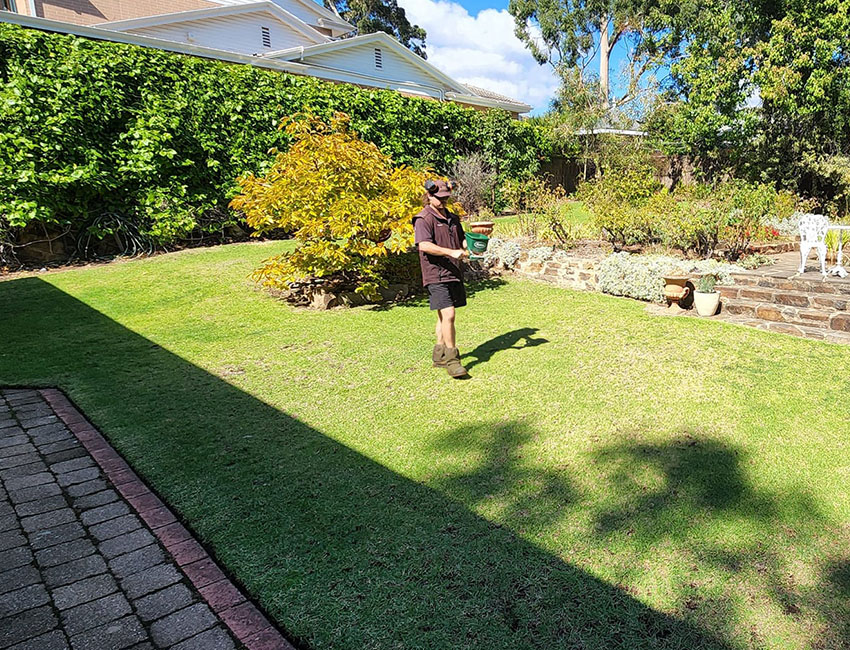Fertilising your lawn is an important aspect of maintaining a healthy, lush lawn.
Fertiliser provides essential nutrients that the grass needs to grow and thrive, including nitrogen, phosphorus, and potassium. It also includes other important micronutrients such as iron, magnesium, and sulphur.
When fertilising your lawn, it’s important to choose the right one for your specific type of grass and the time of year. For example, cool-season grasses, such as Rye and Fescue, should be fertilised in the autumn and spring, while warm-season grasses, such as Kikuyu, Buffalo, and Couch, should be fertilised during the summer months.
The amount and frequency of fertilisation also depend on the type of grass, soil, and weather conditions. Consult with us to determine the right type of fertiliser and schedule for your specific lawn.
It is important to use the correct amount of fertiliser; too little or too much can cause problems. An under-fertilised lawn can be weak and susceptible to disease, while an over-fertilised lawn can lead to a buildup of thatch, increased susceptibility to disease, and environmental pollution. Proper application of fertiliser is important to ensure that the nutrients reach the roots of the grass rather than being washed away or evaporated.
Fertilising your lawn is beneficial not only for its appearance but also for the environment. A healthy lawn can reduce soil erosion, improve water quality, and provide habitat for wildlife. It is important to follow best practises for lawn fertilising to ensure a healthy lawn and a healthy environment.

Hot tip! Avoid fertilising in hot weather and opt for early morning feeding. Make sure to water in before and after so it doesn’t over-nourish and “burn” the lawn.
If your lawn is not responding to a fertiliser it is a good idea to check your soil with a pH testing kit to determine if your soil is too acidic or is lacking a certain nutrient. You can then address specific pH imbalances or nutrient deficiencies.
Let’s chat about nutrients…
The aim of fertilising is to produce a grass that has a vigorous root system of at least 100mm into the soil. The best strategy for turf nutrition is to supply the grass with adequate levels of all nutrients except nitrogen. Growth is then controlled by the application of nitrogen in amounts just sufficient to provide an acceptable appearance.
High levels of phosphorus are unnecessary and waste money. More importantly, it may cause iron deficiency and encourage the growth of weeds such as winter grass (Poa annua). Phosphorus stimulates grasses into producing seed… the last thing that is wanted in a lawn. Excessive phosphorus causes potassium imbalance and the stunting of root growth. Fescues dislike quite small amounts of phosphorus and die out as the phosphorus level in the soil increases.
Potassium is an essential nutrient – valuable for turf because it toughens the leaves so that they are more wear and disease resistant. It promotes the storage of carbohydrates in the roots, and has an essential role in regulating water loss through transpiration. Extra potassium applied in autumn when the grass is going into dormancy will help it survive through winter and enhance its ability to grow quickly in spring.
Iron is the trace element most often in short supply in turf. Deficiencies are associated with high soil pH, excessive applications of phosphorus, waterlogging and excessive thatch.
Other trace elements needed by turf grasses are manganese, magnesium, and copper. Symptoms of deficiencies are reduced growth and paleness of the grass. The turf will look sparse and weak when the nutrient deficiencies are severe.
The goal of any fertilisation program is to provide the lawn with the nutrients it needs for optimum growth. The most accurate way to find out those needs is to have the soil tested. The soil is the conveyor of nutrients to all the plants in your landscape
The best time to fertilise your lawn is when it’s actively growing and in need of nutrients. This means beginning the program about six weeks after spring green-up and stopping about one month before the first frost in early winter.
When the cool weather returns in autumn, the lawn should again be fertilised. A late autumn application has been shown to increase lawn quality the following spring. Fertiliser application dates and frequency are based primarily on which form of nitrogen the fertiliser contains.
Those that have at least one-half of its nitrogen in slow-release form should be adequate for 6 to 8 weeks. If the lawn still has good colour and is growing well at the end of this period, then delay the next application a little longer.